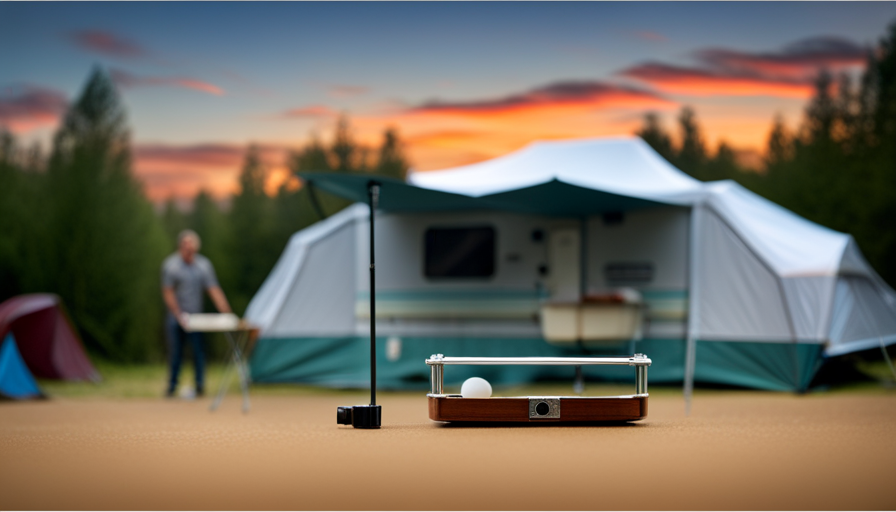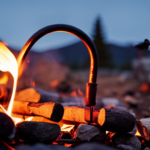Imagine this scenario: you are in the midst of nature, having a tranquil camping experience with your loved ones. As the sun goes down and the stars light up the sky, you return to your camper to unwind. However, as you prepare for bed, you spot a confusing message on the control panel: DSI FLT. What exactly does this message signify? And most importantly, is there cause for alarm?
In the world of campers, DSI FLT stands for Direct Spark Ignition Fault. It’s a warning sign that something is amiss with your camper’s ignition system. Ignition systems are crucial for a camper’s operation, as they provide the spark needed to start the furnace, water heater, and other appliances.
Understanding the significance of DSI FLT and knowing how to troubleshoot and prevent such errors can help ensure a stress-free camping experience.
In this article, we’ll delve into the meaning of DSI FLT and explore common causes of these errors. We’ll also provide step-by-step troubleshooting tips and highlight the importance of regular maintenance for your camper’s ignition system.
So let’s get started and unravel the mystery of DSI FLT!
Key Takeaways
- DSI FLT stands for Direct Spark Ignition Fault in campers and indicates a problem with the ignition system.
- Troubleshooting the ignition system involves checking the power supply and propane tanks, inspecting and cleaning the electrodes, and ensuring all components are in working order.
- Regular maintenance of the ignition system is important for a smooth camping experience and can prevent DSI FLT issues.
- Ignoring regular maintenance can lead to costly repairs, compromised safety, and potential ignition system failure.
Understanding DSI FLT: What Does it Mean?
DSI FLT stands for Direct Spark Ignition Fault, indicating a potential issue with the ignition system in your camper. When you see this message, it means that there is a problem with the spark ignition system, which is responsible for igniting the propane in your camper’s furnace or water heater.
It’s important to address this issue promptly, as a faulty ignition system can prevent your appliances from working properly. To troubleshoot the ignition system, you can start by checking the power supply and making sure the propane tanks are full. Next, inspect the electrodes and clean them if necessary. It’s also a good idea to refer to your camper’s maintenance checklist to ensure all components are in working order.
Maintaining your camper’s ignition system is crucial for a smooth camping experience. The ignition system is responsible for starting the furnace and water heater, which are essential for comfort during your trip. Without a properly functioning ignition system, you may face issues such as lack of heat or hot water.
In the subsequent section about the significance of the ignition system in campers, we will discuss the importance of regular maintenance and the potential consequences of neglecting the ignition system.
The Significance of the Ignition System in Campers
The ignition system in campers plays an incredibly vital role, igniting the fuel mixture in a spectacular display of power and efficiency. Maintaining the ignition system is crucial for optimal performance and to avoid any unexpected issues on your camping trip.
Here are four key points to remember about the significance of the ignition system in campers:
-
Regular Ignition System Maintenance: Just like any other component in your camper, the ignition system requires periodic maintenance. This includes checking and replacing spark plugs, ensuring proper electrical connections, and cleaning any debris or buildup that may affect its functionality.
-
Efficient Fuel Ignition: The ignition system ensures that the fuel mixture is ignited at the right time and in the right amount. This efficient ignition process contributes to better fuel efficiency, smoother engine operation, and overall improved performance.
-
Troubleshooting Ignition Issues: If you experience any ignition-related problems, such as difficulty starting the camper or engine misfires, it’s important to troubleshoot the ignition system. This may involve checking the battery, ignition coil, or control module for any faults or malfunctions.
-
Common Causes of DSI FLT Errors: Now, let’s delve into the common causes of DSI FLT errors, which are related to the Direct Spark Ignition Flame Loss Troubleshooting system.
Common Causes of DSI FLT Errors
One of the most prevalent causes of DSI FLT errors is a faulty ignition coil, leading to potential issues with the camper’s fuel ignition system. The ignition coil plays a crucial role in generating the high voltage needed to ignite the fuel mixture in the combustion chamber. When it malfunctions, it can result in a weak spark or no spark at all, causing the DSI FLT error to occur.
To troubleshoot this issue, start by checking the ignition coil for any signs of damage or wear. Look for cracks, corrosion, or loose connections. If any issues are found, it’s essential to replace the faulty ignition coil with a new one. Additionally, inspect the spark plug wires and ensure they are securely connected to both the ignition coil and spark plugs.
Preventive measures can also be taken to minimize the chances of encountering DSI FLT errors. Regularly inspect and maintain the ignition system components, including the ignition coil, spark plugs, and spark plug wires. Clean any debris or dirt that may accumulate around these components, as they can hinder their performance. By following these preventive measures, you can reduce the likelihood of experiencing DSI FLT errors and ensure the smooth operation of your camper’s ignition system.
Moving on to troubleshooting steps for resolving DSI FLT issues…
Troubleshooting Steps for Resolving DSI FLT Issues
To troubleshoot and resolve DSI FLT issues, you can follow these simple steps.
First, check the propane supply and ensure it’s turned on. Insufficient propane can cause the DSI FLT error to occur.
Next, inspect the burner tube for any obstructions or debris that may be blocking the flow of propane. Clean the burner tube if necessary.
Additionally, verify that the spark electrode is clean and properly positioned. A dirty or misaligned spark electrode can prevent the ignition system from functioning correctly.
If the issue persists, check the wiring connections to ensure they’re secure and free from any damage. Faulty or loose connections can disrupt the ignition process.
Lastly, if none of these steps resolve the DSI FLT error, it may be necessary to consult a professional technician for further assistance.
Regular maintenance is crucial for the proper functioning of camper ignition systems. Ignoring maintenance can lead to more frequent DSI FLT issues and potentially compromise the safety of your camper.
By regularly inspecting and cleaning the burner tube, spark electrode, and wiring connections, you can prevent issues from arising in the first place. Regular maintenance also allows you to identify and address any potential problems before they escalate into major issues.
So, make sure to prioritize regular maintenance for your camper’s ignition system to ensure a smooth and trouble-free camping experience.
Importance of Regular Maintenance for Camper Ignition Systems
Regular maintenance is crucial for camper owners to ensure that their ignition systems function smoothly and without any unexpected issues occurring. Ignition systems in campers are responsible for starting the engine and powering various electrical components. Neglecting regular maintenance can lead to problems such as difficulty starting the engine, stalling, or even complete failure.
To avoid these issues, camper owners should prioritize regular camper ignition maintenance. One important aspect of maintenance is checking and replacing spark plugs regularly. Spark plugs can become worn or fouled over time, affecting the ignition system’s performance. It’s also essential to inspect the ignition wires for any signs of wear or damage. Faulty wires can cause irregular sparks or even prevent the spark from reaching the spark plugs.
Additionally, it’s necessary to clean or replace the ignition coil if necessary. The ignition coil plays a vital role in generating the high voltage needed for the spark plugs to ignite the fuel mixture. Over time, the coil can deteriorate or become faulty, leading to ignition problems.
Regular camper ignition maintenance is crucial for ensuring a smooth and reliable operation. By checking and replacing spark plugs, inspecting ignition wires, and maintaining the ignition coil, camper owners can prevent unexpected issues. This proactive approach to maintenance will help avoid costly repairs and keep the ignition system functioning optimally.
Next, we’ll discuss when it’s necessary to seek professional help for more complex camper ignition troubleshooting.
Seeking Professional Help: When to Call a Mechanic
If you’re experiencing persistent ignition issues that leave you stranded on the side of the road, it’s time to call a mechanic for professional help. Ignition system failure can be a frustrating and potentially dangerous problem, so it’s important to know when it’s time to seek professional assistance.
Here are three signs that indicate it’s time to call a mechanic:
-
Persistent Starting Problems: If your camper has difficulty starting or if it takes multiple attempts to get the engine running, it could be a sign of ignition system failure. A mechanic will be able to diagnose the issue and recommend the necessary repairs.
-
Engine Misfires: A misfiring engine can indicate a problem with the ignition system. If you notice a loss of power, rough idling, or unusual noises coming from the engine, it’s best to have a mechanic inspect the ignition system.
-
Warning Lights: If the check engine light or any other warning lights related to the ignition system come on, it’s a clear indication that something is wrong. A mechanic will be able to read the error codes and determine the cause of the problem.
Calling a mechanic for professional help is essential when dealing with ignition system failure. They have the knowledge and expertise to diagnose and fix the issue, ensuring your camper is back on the road safely.
In the next section, we’ll discuss preventive measures to avoid dsi flt errors.
Preventive Measures to Avoid DSI FLT Errors
Make sure you regularly check and maintain your camper’s ignition system to avoid potential DSI FLT errors. Avoiding DSI FLT errors can save you from the hassle and expense of calling a mechanic. Here are some preventive measures and troubleshooting tips to help you keep your camper running smoothly.
First and foremost, always keep an eye on the DSI FLT indicator light. If it starts flashing or remains lit, it’s a clear sign that something’s wrong. In such cases, the first step is to turn off the DSI system and wait for it to cool down before attempting any troubleshooting.
Next, check the gas supply. Ensure that the propane tank is full and the gas lines are free from any leaks or blockages. It’s also essential to verify that the gas pressure is within the recommended range.
Regularly inspect the burner assembly and clean it from any debris or residue. Make sure the electrode is properly positioned and not damaged. Additionally, check the wiring connections to ensure they’re secure and not corroded.
If you’re unsure about any aspect of troubleshooting or maintenance, don’t hesitate to consult the owner’s manual or contact the manufacturer for guidance.
By following these preventive measures and troubleshooting tips, you can avoid DSI FLT errors and ensure a safe and enjoyable camping experience. In the next section, we’ll discuss the potential risks and precautions associated with DSI FLT and camper safety.
DSI FLT and Safety: Potential Risks and Precautions
Now that we’ve discussed preventive measures to avoid DSI FLT errors, let’s focus on the importance of DSI FLT and propane safety, as well as the potential risks associated with DSI FLT errors.
DSI FLT, which stands for Direct Spark Ignition Fault, is a safety feature found in many campers that use propane as a source of energy. Its main purpose is to ensure that the propane is ignited safely and efficiently. However, if there’s an error with the DSI FLT system, it can lead to potential risks.
One of the risks of DSI FLT errors is the improper ignition of propane, which can result in a propane leak or a buildup of propane inside the camper. This poses a serious safety hazard, as propane is highly flammable and can lead to fires or explosions.
To prevent these risks, it’s crucial to regularly inspect and maintain the DSI FLT system. This includes checking for any loose connections, cleaning the igniter, and ensuring that the propane supply is regulated properly. Additionally, it’s important to familiarize yourself with the camper’s user manual and follow all safety guidelines provided.
By taking these precautions and being vigilant about DSI FLT and propane safety, you can minimize the potential risks associated with DSI FLT errors and ensure a safe camping experience. Now, let’s move on to exploring other common camper acronyms and their meanings.
Exploring Other Common Camper Acronyms and their Meanings
Let’s dive into the world of camper acronyms and uncover the meanings behind some common abbreviations. Understanding camper electrical systems is essential for maintaining your camper and ensuring a stress-free camping experience. Here are three common camper acronyms and their meanings:
-
DSI – Direct Spark Ignition: DSI is a feature found in some campers’ water heaters. It allows for easy and efficient ignition of the water heater, providing hot water quickly. If you see "DSI FLT" on your camper, it may indicate a fault in the DSI system that needs to be addressed.
-
RV – Recreational Vehicle: RV is a term used to describe a motorized or towable camper that provides living accommodations and amenities while on the road. Understanding the various components and systems in an RV is crucial for proper maintenance and enjoyment.
-
AC – Air Conditioning: AC refers to the cooling system in a camper. It helps regulate the temperature inside the camper, providing comfort during hot summer days. Regular maintenance of the AC unit, including cleaning and filter replacement, is necessary to ensure optimal performance.
By familiarizing yourself with these acronyms and incorporating them into your camper maintenance checklist, you can stay on top of any potential issues and keep your camper in excellent condition.
Now, let’s move on to the next section, where we will explore tips for enjoying a stress-free camping experience through proper maintenance and care.
Enjoying a Stress-Free Camping Experience: Tips for Camper Maintenance and Care
To ensure a stress-free camping experience, it’s important to prioritize proper maintenance and care for your camper. By regularly inspecting and servicing your RV’s electrical systems, you can avoid unexpected issues and enjoy your time in nature without any worries.
For example, imagine you’re on a cross-country road trip with your family, and you notice that the air conditioning in your camper isn’t cooling efficiently. By cleaning and replacing the AC filters regularly, you can ensure a comfortable and enjoyable trip for everyone.
To start, it’s helpful to have a camper maintenance checklist to ensure you’re covering all the necessary tasks. This checklist should include items such as checking the tires for wear and proper inflation, inspecting the roof for any leaks or damage, testing the brakes and lights, and lubricating moving parts like hinges and locks. By following this checklist regularly, you can catch any potential issues before they become major problems.
In addition to maintenance, having essential camper accessories can greatly enhance your camping experience. These accessories can include items like leveling blocks to stabilize your camper, a surge protector to safeguard your electrical system, and a sewer hose for waste disposal. Investing in these accessories not only improves convenience but also helps maintain the longevity of your camper.
By taking the time to properly maintain and care for your camper, you can enjoy a stress-free camping experience filled with comfort and peace of mind. So, make sure to follow a maintenance checklist and equip your camper with essential accessories to ensure a worry-free adventure in the great outdoors.
Frequently Asked Questions
What are some other common acronyms used in camper maintenance and their meanings?
Understanding camper maintenance involves familiarizing oneself with common acronyms used in the industry. These acronyms provide valuable information about various aspects of camper maintenance.
Some examples include:
- RV (Recreational Vehicle)
- HVAC (Heating, Ventilation, and Air Conditioning)
- LP (Liquid Propane)
- AWG (American Wire Gauge)
Knowing these acronyms helps campers identify and troubleshoot issues efficiently. By staying informed about these terms, campers can maintain their vehicles effectively and ensure a smooth and enjoyable camping experience.
How can I prevent DSI FLT errors from occurring in my camper?
To prevent DSI FLT errors from occurring in your camper, there are a few troubleshooting steps you can take.
First, ensure that the propane tank isn’t empty and that the gas valve is open.
Next, check the connections and wires for any damage or corrosion.
If everything appears to be in order, you can try resetting the DSI FLT error by turning off the propane and electrical power to your camper for a few minutes before turning them back on.
What are the potential risks associated with DSI FLT errors and what precautions should I take?
Potential risks associated with DSI FLT errors in campers can include gas leaks, fires, or explosions. To mitigate these risks, it’s crucial to take necessary precautions.
Firstly, regular maintenance and inspections of the camper’s gas system should be conducted by a trained professional.
Additionally, always ensure proper ventilation when using gas appliances. It’s advisable to have a fire extinguisher on board and to familiarize yourself with its usage.
Lastly, promptly address any DSI FLT error codes to prevent potential hazards.
When should I seek professional help for DSI FLT issues and when can I troubleshoot them myself?
When it comes to DSI FLT issues, knowing when to seek professional help or troubleshoot them yourself is crucial.
While some problems can be easily resolved with a bit of troubleshooting, others may require the expertise of a professional.
When facing complex issues or if you’re unsure about your skills, it’s wise to seek professional help.
However, for minor problems like simple error codes, troubleshooting can be done by following the manufacturer’s guidelines or consulting online resources.
What are some tips for maintaining and caring for my camper to ensure a stress-free camping experience?
Maintaining and caring for your camper is crucial to ensuring a stress-free camping experience. Proper camper storage is essential to prevent damage from the elements.
It’s important to clean your camper regularly, both inside and out, and to check for any signs of wear and tear.
Additionally, having essential camping gear, such as a first aid kit, camping stove, and sleeping bags, is vital for a comfortable and enjoyable trip.
Conclusion
In conclusion, understanding the meaning of DSI FLT on your camper is crucial for maintaining a stress-free camping experience. While it may seem like a daunting acronym, knowing the common causes and troubleshooting steps can help resolve any issues that arise. Knowing the DSI FLT can also help you determine the best camper living locations to avoid potential problems. By understanding how the DSI FLT works, you can choose campsites with reliable gas and electrical systems, ensuring a smoother camping experience. In the end, familiarizing yourself with this acronym can ultimately enhance your enjoyment of the great outdoors.
Regular maintenance and preventive measures are key to avoiding DSI FLT errors in the future. Remember, staying informed and taking proper precautions will ensure your safety and enjoyment while exploring the great outdoors.
So, embrace the complexity of your camper’s ignition system and embark on your camping adventures with confidence!



















